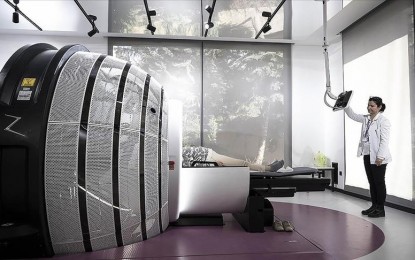
ANKARA – A robotic medical device has served to treat the progressive hearing loss of an elderly patient in one of Türkiye’s well-known University Medical schools in Ankara.
One of the 18 advanced technologies in the world, the robotic gyroscopic radiosurgery device, Zap-X, was first used to heal patients at Hacettepe University Medical School in Ankara.
One of the first patients to be treated with Zap-X was retired English teacher Gunsel Karaca, 64, who was grappling with a tumor that emerged in her hearing and balances vestibular nerves.
After the application of Zap-X, Karaca’s tumor stopped growing and she was saved from the risk of completely losing her hearing.
‘It is a tumor difficult to eliminate.’
The head of the radiation oncology department at Hacettepe Gokhan Ozyigit shared information regarding radiosurgery treatment with Zap-X. He underlined that the device has features that can perform much more sensitive treatments.
Ozyigit emphasized that Karaca had a tumor called “acoustic neuroma.”
“This is a tumor that is challenging to remove surgically and is especially affecting the auditory nerve. Patients usually come to us with hearing loss. With these tumors, surgery in that area can cause hearing loss to deteriorate. The Zap-X device can easily treat these challenging tumors.
“We may not be able to reverse the existing hearing loss, but we can forestall the loss from progressing further and stop the growth of the tumor,” he said.
It takes half an hour, no surgery performed
Ozyigit stressed that acoustic neuroma is a benign tumor. But, when it grows, there is a danger of compressing the brainstem and causing more severe health problems.
Highlighting that patients can listen to music during the treatment and return to their everyday lives on the same day, Ozyigit emphasized that in Zap-X, the treatment is carried out with ionizing radiation and there is no surgical procedure.
‘It substantially reduces adverse impacts’
Dr. Gozde Yazici, a member of the radiation oncology department, pointed out that due to Zap-X’s structure, it can currently only be harnessed in the upper part of the head and neck. She said with developments, the device will be compatible with the lower part of the neck in the coming months.
“The most important aspect of Zap-X is that it substantially reduces the adverse impacts that may arise in the patient with a rapid dose reduction and provides more comfortable treatment opportunities. This technology is also very favorable for some eye tumors, and can treat malignant eye lesions while preserving the eye and vision,” she said.
Highlighting that she was glad to stop her disease from spreading, Karaca said, “My “first complaints started with hearing loss six years ago. I ignored it at first, but then I started having vertigo attacks, inflammation in my ear and balance problems.”
She said although she was seen by different specialists and bought a hearing aid for hearing loss, her disease could not be diagnosed for some time. After starting being diagnosed in Hacettepe, she received treatment 1.5 months ago.
“I am very happy now and have an active life. I hope my hearing loss will stop at the current point, and I hope the tumor will shrink. I did not feel nervous at all while receiving the treatment at Zap-X. It went very well. They played music for me. After receiving the treatment, I did not experience any discomfort.
“I had no side effects or problems. I returned to my life,” she said. (Anadolu)
